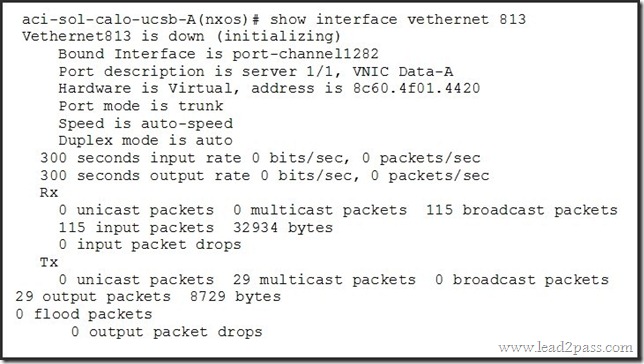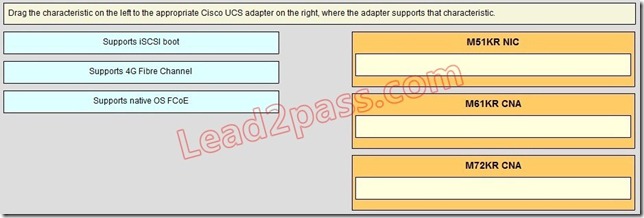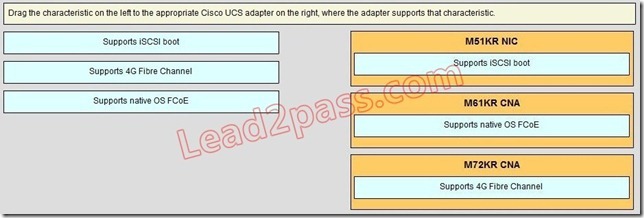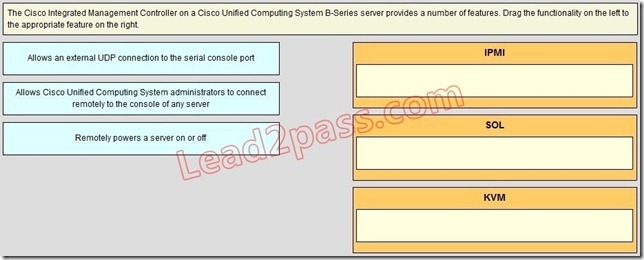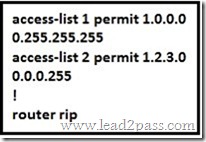Lead2pass 300-135 New Questions Free Download:
https://www.lead2pass.com/300-135.html
QUESTION 41
The implementations group has been using the test bed to do a `proof-of-concept’ that requires both Client 1 and Client 2 to access the WEB Server at 209.65.200.241. After several changes to the network addressing, routing scheme, DHCP services, NTP services, and FHRP services, a trouble ticket has been operated indicating that Client 1 cannot ping the 209.65.200.241 address.
Use the supported commands to Isolated the cause of this fault and answer the following questions.
On which device is the fault condition located?
A. R1
B. R2
C. R3
D. R4
E. DSW1
F. DSW2
G. ASW1
H. ASW2

Answer: G
Explanation:
Since the Clients are getting an APIPA we know that DHCP is not working. However, upon closer examination of the ASW1 configuration we can see that the problem is not with DHCP, but the fact that the trunks on the port channels are only allowing VLANs 1-9, when the clients belong to VLAN 10. VLAN 10 is not traversing the trunk on ASW1, so the problem is with the trunk configuration on ASW1.
QUESTION 42
The implementations group has been using the test bed to do a `proof-of-concept’ that requires both Client 1 and Client 2 to access the WEB Server at 209.65.200.241. After several changes to the network addressing, routing scheme, DHCP services, NTP services, and FHRP services, a trouble ticket has been opened indicating that Client 1 cannot ping the 209.65.200.241 address.
Use the supported commands to isolated the cause of this fault and answer the following questions.
The fault condition is related to which technology?
A. NTP
B. Switch-to-Switch Connectivity
C. Access Vlans
D. Port Security
E. VLAN ACL / Port ACL
F. Switch Virtual Interface
Answer: B
Explanation:
Since the Clients are getting an APIPA we know that DHCP is not working. However, upon closer examination of the ASW1 configuration we can see that the problem is not with DHCP, but the fact that the trunks on the port channels are only allowing VLANs 1-9, when the clients belong to VLAN 10. VLAN 10 is not traversing the trunk on ASW1, so the problem is with switch to switch connectivity, specifically the trunk configuration on ASW1.
QUESTION 43
The implementations group has been using the test bed to do a `proof-of-concept’ that requires both Client 1 and Client 2 to access the WEB Server at 209.65.200.241. After several changes to the network addressing, routing scheme, DHCP services, NTP services, and FHRP services, a trouble ticket has been opened indicating that Client 1 cannot ping the 209.65.200.241 address.
Use the supported commands to isolated the cause of this fault and answer the following questions.
What is the solution to the fault condition?
A. In Configuration mode, using the interface port-channel 13 command, then configure switchport trunk allowed vlan none followed by switchport trunk allowed vlan 20,200 commands.
B. In Configuration mode, using the interface port-channel 13, port-channel 23, then configure switchport trunk none allowed vlan none followed by switchport trunk allowed vlan 10,200 commands.
C. In Configuration mode, using the interface port-channel 23 command, then configure switchport trunk allowed vlan none followed by switchport trunk allowed vlan 20,200 commands.
D. In Configuration mode, using the interface port-channel 23, port-channel, then configure switchport trunk allowed vlan none followed by switchport trunk allowed vlan 10,20,200 commands.
Answer: B
Explanation:
We need to allow VLANs 10 and 200 on the trunks to restore full connectivity. This can be accomplished by issuing the “switchport trunk allowed vlan 10,200” command on the port channels used as trunks in DSW1.
Ticket 2 : ACCESS VLAN
Topology Overview (Actual Troubleshooting lab design is for below network design)
– Client Should have IP 10.2.1.3
– EIGRP 100 is running between switch DSW1 & DSW2
– OSPF (Process ID 1) is running between R1, R2, R3, R4
– Network of OSPF is redistributed in EIGRP
– BGP 65001 is configured on R1 with Webserver cloud AS 65002
– HSRP is running between DSW1 & DSW2 Switches
The company has created the test bed shown in the layer 2 and layer 3 topology exhibits.
This network consists of four routers, two layer 3 switches and two layer 2 switches.
In the IPv4 layer 3 topology, R1, R2, R3, and R4 are running OSPF with an OSPF process number 1.
DSW1, DSW2 and R4 are running EIGRP with an AS of 10. Redistribution is enabled where necessary.
R1 is running a BGP AS with a number of 65001. This AS has an eBGP connection to AS 65002 in the ISP’s network. Because the company’s address space is in the private range.
R1 is also providing NAT translations between the inside (10.1.0.0/16 & 10.2.0.0/16) networks and outside (209.65.0.0/24) network.
ASW1 and ASW2 are layer 2 switches.
NTP is enabled on all devices with 209.65.200.226 serving as the master clock source.
The client workstations receive their IP address and default gateway via R4’s DHCP server.
The default gateway address of 10.2.1.254 is the IP address of HSRP group 10 which is running on DSW1 and DSW2.
In the IPv6 layer 3 topology R1, R2, and R3 are running OSPFv3 with an OSPF process number 6.
DSW1, DSW2 and R4 are running RIPng process name RIP_ZONE.
The two IPv6 routing domains, OSPF 6 and RIPng are connected via GRE tunnel running over the underlying IPv4 OSPF domain. Redistrution is enabled where necessary.
Recently the implementation group has been using the test bed to do a `proof-of-concept’ on several implementations. This involved changing the configuration on one or more of the devices. You will be presented with a series of trouble tickets related to issues introduced during these configurations.
Note: Although trouble tickets have many similar fault indications, each ticket has its own issue and solution.
Each ticket has 3 sub questions that need to be answered & topology remains same.
Question-1 Fault is found on which device,
Question-2 Fault condition is related to,
Question-3 What exact problem is seen & what needs to be done for solution
Client is unable to ping IP 209.65.200.241
Solution:
Steps need to follow as below:
– When we check on client 1 & Client 2 desktop we are not receiving DHCP address from R4 Ipconfig — — Client will be getting 169.X.X.X.
– On ASW1 port Fa1/0/ 1 & Fa1/0/2 access port VLAN 10 was assigned which is using IP address 10.2.1.0/24.
Sh run ——- & check for running config of int fa1/0/1 & fa1/0/2 ====================================================
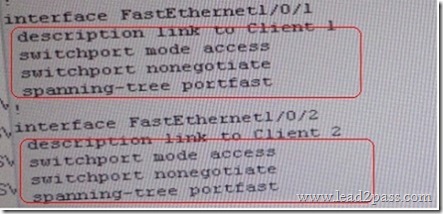
====================================================
Here we are not able to see access Vlan10 configured for Port Fa1/0/1 & Fa1/0/2 Change required: On ASW1, for configuring Access Vlan under interface fa1/0/1 & 1/0/2 we have to enable command switchport access vlan 10
QUESTION 44
The implementations group has been using the test bed to do a `proof-of-concept’ that requires both Client 1 and Client 2 to access the WEB Server at 209.65.200.241. After several changes to the network addressing, routing scheme, DHCP services, NTP services, layer 2 connectivity, FHRP services, and device security, a trouble ticket has been opened indicating that Client 1 cannot ping the 209.65.200.241 address.
Use the supported commands to isolated the cause of this fault and answer the following questions.
What is the solution to the fault condition?
A. R1
B. R2
C. R3
D. R4
E. DSW1
F. DSW2
G. ASW1
H. ASW2
Answer: G
Explanation:
The problem here is that VLAN 10 is not configured on the proper interfaces on switch ASW1.
QUESTION 45
The implementations group has been using the test bed to do a `proof-of-concept’ that requires both Client 1 and Client 2 to access the WEB Server at 209.65.200.241. After several changes to the network addressing, routing scheme, DHCP services, NTP services, layer 2 connectivity, FHRP services, and device security, a trouble ticket has been opened indicating that Client 1 cannot ping the 209.65.200.241 address.
Use the supported commands to isolated the cause of this fault and answer the following questions.
The fault condition is related to switch technology?
A. NTP
B. Switch-to-Switch Connectivity
C. Loop Prevention
D. Access Vlans
E. VLAN ACL Port ACL
F. Switch Virtual Interface
G. Port Security
Answer: D
Explanation:
The problem here is that VLAN 10 is not configured on the proper interfaces on switch ASW1.
QUESTION 46
The implementations group has been using the test bed to do a `proof-of-concept’ that requires both Client 1 and Client 2 to access the WEB Server at 209.65.200.241. After several changes to the network addressing, routing scheme, DHCP services, NTP services, layer 2 connectivity, FHRP services, and device security, a trouble ticket has been opened indicating that Client 1 cannot ping the 209.65.200.241 address.
Use the supported commands to isolated the cause of this fault and answer the following questions.
What is the solution to the fault condition?
A. In Configuration mode, using the interface range Fastethernet 1/0/1 ?2, then switchport mode access vlan 10 command.
B. In Configuration mode, using the interface range Fastethernet 1/0/1 ?2, then switchport access mode vlan 10 command.
C. In Configuration mode, using the interface range Fastethernet 1/0/1 ?2, then switchport vlan 10 access command.
D. In Configuration mode, using the interface range Fastethernet 1/0/1 ?2, then switchport access vlan 10 command.
Answer: D
Explanation:
The problem here is that VLAN 10 is not configured on the proper interfaces on switch ASW1.
Ticket 3 : OSPF Authentication
Topology Overview (Actual Troubleshooting lab design is for below network design)
– Client Should have IP 10.2.1.3
– EIGRP 100 is running between switch DSW1 & DSW2
– OSPF (Process ID 1) is running between R1, R2, R3, R4
– Network of OSPF is redistributed in EIGRP
– BGP 65001 is configured on R1 with Webserver cloud AS 65002
– HSRP is running between DSW1 & DSW2 Switches
The company has created the test bed shown in the layer 2 and layer 3 topology exhibits.
This network consists of four routers, two layer 3 switches and two layer 2 switches.
In the IPv4 layer 3 topology, R1, R2, R3, and R4 are running OSPF with an OSPF process number 1.
DSW1, DSW2 and R4 are running EIGRP with an AS of 10. Redistribution is enabled where necessary.
R1 is running a BGP AS with a number of 65001. This AS has an eBGP connection to AS 65002 in the ISP’s network. Because the company’s address space is in the private range.
R1 is also providing NAT translations between the inside (10.1.0.0/16 & 10.2.0.0/16) networks and outside (209.65.0.0/24) network.
ASW1 and ASW2 are layer 2 switches.
NTP is enabled on all devices with 209.65.200.226 serving as the master clock source.
The client workstations receive their IP address and default gateway via R4’s DHCP server.
The default gateway address of 10.2.1.254 is the IP address of HSRP group 10 which is running on DSW1 and DSW2.
In the IPv6 layer 3 topology R1, R2, and R3 are running OSPFv3 with an OSPF process number 6.
DSW1, DSW2 and R4 are running RIPng process name RIP_ZONE.
The two IPv6 routing domains, OSPF 6 and RIPng are connected via GRE tunnel running over the underlying IPv4 OSPF domain. Redistrution is enabled where necessary.
Recently the implementation group has been using the test bed to do a `proof-of-concept’ on several implementations. This involved changing the configuration on one or more of the devices. You will be presented with a series of trouble tickets related to issues introduced during these configurations.
Note: Although trouble tickets have many similar fault indications, each ticket has its own issue and solution.
Each ticket has 3 sub questions that need to be answered & topology remains same.
Question-1 Fault is found on which device,
Question-2 Fault condition is related to,
Question-3 What exact problem is seen & what needs to be done for solution
Client is unable to ping IP 209.65.200.241
Solution:
Steps need to follow as below:
– When we check on client 1 & Client 2 desktop we are not receiving DHCP address from R4 Ipconfig —– Client will be receiving IP address 10.2.1.3
– IP 10.2.1.3 will be able to ping from R4 , R3, R2 but not from R1

– Check for neighborship of ospf
sh ip ospf nei —– Only one neighborship is forming with R2 & i.e. with R3
Since R2 is connected to R1 & R3 with routing protocol ospf than there should be 2 neighbors seen but only one is seen
– Need to check running config of R2 & R3 for interface
Sh run ————————– Interface Serial0/0/0/0.12 on R2
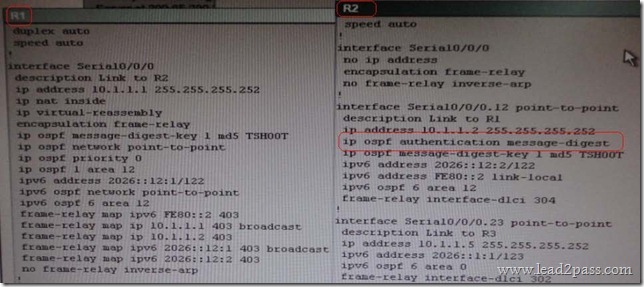
– Sh run ————————– Interface Serial0/0/0/0 on R1
– Change required: On R1, for IPV4 authentication of OSPF command is missing and required to configure—— ip ospf authentication message-digest
QUESTION 47
The implementations group has been using the test bed to do a `proof-of-concept’ that requires both Client 1 and Client 2 to access the WEB Server at 209.65.200.241. After several changes to the network addressing, routing scheme, DHCP services, NTP services, layer 2 connectivity, FHRP services, and device security, a trouble ticket has been opened indicating that Client 1 cannot ping the 209.65.200.241 address.
Use the supported commands to isolated the cause of this fault and answer the following questions.
On which device is the fault condition located?
A. R1
B. R2
C. R3
D. R4
E. DSW1
F. DSW2
G. ASW1
H. ASW2
Answer: A
Explanation:
As you will see, the problem in this situation is with OSPF on R1. It is missing the “ip ospf authentication message-digest” command on the Serial0/0/0/0.12 interface.
QUESTION 48
The implementations group has been using the test bed to do a `proof-of-concept’ that requires both Client 1 and Client 2 to access the WEB Server at 209.65.200.241. After several changes to the network addressing, routing scheme, DHCP services, NTP services, layer 2 connectivity, FHRP services, and device security, a trouble ticket has been opened indicating that Client 1 cannot ping the 209.65.200.241 address.
Use the supported commands to isolated the cause of this fault and answer the following questions.
The fault condition is related to which technology?
A. BGP
B. NTP
C. IP NAT
D. IPv4 OSPF Routing
E. IPv4 OSPF Redistribution
F. IPv6 OSPF Routing
G. IPv4 layer 3 security
Answer: D
Explanation:
The problem in this situation is with OSPF on router 1. It is missing the “ip ospf authentication messagedigest” command on the Serial0/0/0/0.12 interface.
The problem statement tells us that the two routers are not able to become OSPF neighbors.
300-135 dumps full version (PDF&VCE): https://www.lead2pass.com/300-135.html
Large amount of free 300-135 exam questions on Google Drive: https://drive.google.com/open?id=0B3Syig5i8gpDZmFQVlZDZnpLejA
Maybe you also need:
300-101 exam dumps: https://drive.google.com/open?id=0B3Syig5i8gpDakxVRXg3aUpmTE0
300-115 exam dumps: https://drive.google.com/open?id=0B3Syig5i8gpDM0pqaFJWUXVuM2M
